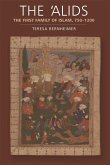As many as 40 different Shii groups existed in the 9th and 10th centuries yet only 3 forms have survived. Why is Twelver Shiism one of themAs the established faith in modern Iran, the majority faith in Iraq and areas in the Gulf and with its adherents forming sizeable minorities elsewhere in the region, Twelver Shi'ism is arguably the most successful branch of Shi'ism. Andrew J. Newman chronicles the progression of Twelver Shiism, exploring the numerous external challenges and internal disagreements that marked the lives of believers in pockets across the Middle East to the early 18th century. During this time, from the 13th to the 15th century especially, with scholarly activity and the availability of earlier key texts of the faith limited, the region's many millenarian doctrines and movements threatened its demise. Only by the late 17th century was Twelver Shiism's survival assured, both in Iran and elsewhere in the region.
THE NEW EDINBURGH ISLAMIC SURVEYS SERIES EDITOR: CAROLE HILLENBRAND Charts the history and development of Twelver Shiism to the 18th century Some 10-15 per cent of the world's one billion Muslims are estimated to be Shiites, and the largest of today's three Shii groups are the Twelver Shia. Theirs is the established faith in modern Iran and the majority faith in Iraq, and it has adherents in Arab countries, the Subcontinent and Afghanistan. Twelvers believe that the Prophet Muhammad's cousin and son-in-law Ali and his descendants should have succeeded the Prophet. Now they await the return of the Twelfth Imam who disappeared in the late 9th century AD. Andrew Newman chronicles the progression of Twelver Shiism, exploring the numerous external challenges and internal disagreements that marked the lives of believers in pockets across the Middle East to the early 18th century. During this time, from the 13th to the 15th century especially, with scholarly activity and the availability of earlier key texts of the faith limited, the region's many millenarian doctrines and movements threatened its demise. Only by the late 17th century was Twelver Shiism's survival assured, both in Iran and elsewhere in the region. Andrew J. Newman is Reader in Islamic Studies and Persian at the University of Edinburgh. He is author of The Formative Period of Shii Law (2000) and Safavid Iran (2006). Cover image: 'The Prophet of Allah (on Him and His family be Blessings) said: "I am the City of Knowledge and Ali is Its gate".', Sultani Madrasa, Isfahan, completed in 1706-07 (c) Andrew J. Newman. Cover design: [EUP logo] www.euppublishing.com
Hinweis: Dieser Artikel kann nur an eine deutsche Lieferadresse ausgeliefert werden.
THE NEW EDINBURGH ISLAMIC SURVEYS SERIES EDITOR: CAROLE HILLENBRAND Charts the history and development of Twelver Shiism to the 18th century Some 10-15 per cent of the world's one billion Muslims are estimated to be Shiites, and the largest of today's three Shii groups are the Twelver Shia. Theirs is the established faith in modern Iran and the majority faith in Iraq, and it has adherents in Arab countries, the Subcontinent and Afghanistan. Twelvers believe that the Prophet Muhammad's cousin and son-in-law Ali and his descendants should have succeeded the Prophet. Now they await the return of the Twelfth Imam who disappeared in the late 9th century AD. Andrew Newman chronicles the progression of Twelver Shiism, exploring the numerous external challenges and internal disagreements that marked the lives of believers in pockets across the Middle East to the early 18th century. During this time, from the 13th to the 15th century especially, with scholarly activity and the availability of earlier key texts of the faith limited, the region's many millenarian doctrines and movements threatened its demise. Only by the late 17th century was Twelver Shiism's survival assured, both in Iran and elsewhere in the region. Andrew J. Newman is Reader in Islamic Studies and Persian at the University of Edinburgh. He is author of The Formative Period of Shii Law (2000) and Safavid Iran (2006). Cover image: 'The Prophet of Allah (on Him and His family be Blessings) said: "I am the City of Knowledge and Ali is Its gate".', Sultani Madrasa, Isfahan, completed in 1706-07 (c) Andrew J. Newman. Cover design: [EUP logo] www.euppublishing.com
Hinweis: Dieser Artikel kann nur an eine deutsche Lieferadresse ausgeliefert werden.








